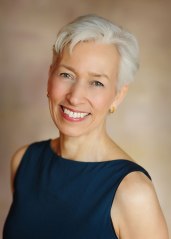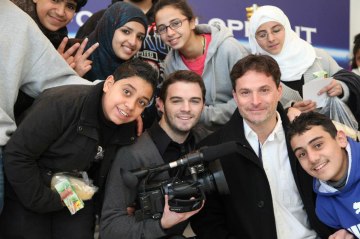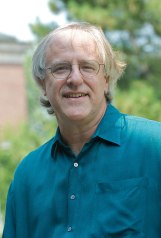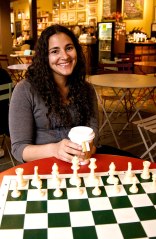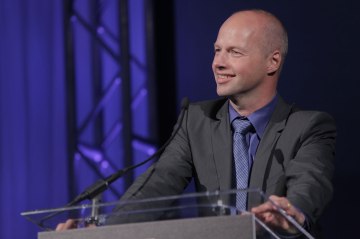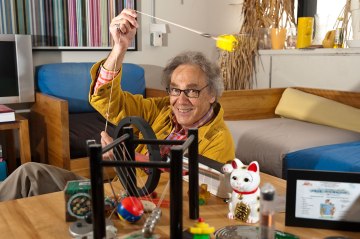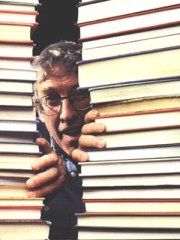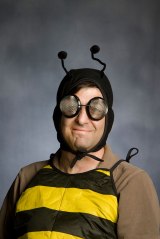From left: David Petraeus, Bob Woodward.
This year, a pair of famous figures will be joining celebrity professors like James Franco in front of America’s college classrooms.
Former CIA director David Petraeus will be teaching a course at the City University of New York called “Are We on the Threshold of the North American Decade?” for the salary of one dollar. And Bob Woodward—the reporter who broke open Watergate with Carl Bernstein—is taking his talents to his alma mater Yale University to teach a journalism seminar.
But professors don’t have to be famous to be big names on campus. Some have hundreds or even thousands of students competing for a seat in their class. Others have developed cult followings of a few dedicated acolytes. As undergrads head back to campus, TIME surveyed students to gather the unofficial list of teaching stars.
.
Amy Boesky, “Early Women Writers” at Boston College
Amy Boesky serves as the informal professional guru of Chestnut Hill. Described as “the aunt you always wanted” by former student James Melia, she often steers students towards publishing careers and helps them make connections in the industry. And she’s hardly a dusty Elizabethan don; Boesky spent some of her twenties ghostwriting teen novels for the “Sweet Valley High” series. She also teaches creative nonfiction and directs the English Department’s Honors Program..
.
John Stilgoe, “Adventure and Fantasy Simulation” at Harvard University
Stilgoe is famous for his bowtie and his pre-class Oreo habit, but this notoriously eccentric professor is particular about nearly everything. His classes on the built North American environment cover objects in everyday life from gas stations to Coca-Cola to the varieties of yellow on Kodak cameras. He also teaches courses on seascapes and adventure fantasy, which are nearly impossible to take without his personal approval. Stilgoe is famously handy with cars, boats and tools (he built parts of his home himself) but rejects digital conveniences; instead of listing his email address, he just writes “no.”
Nina Jablonski, “Skin” at Pennsylvania State University
Jablonski studies skin from an evolutionary and anthropological perspective, and focuses on everything from the evolution of skin color to the cultural significance of piercings; her TED talk on skin color has gotten over half a million views. “When we walk into a room, our skin introduces us before we ever open our mouths,” she said. “I want students to appreciate just how important these visual impressions are.” She’s teaching “Primatology” this year as she re-tools her famous class, “Skin” to be offered again next fall. “Students love to learn about tattoos,” she said, “since most of them have them now.”
.
Bob Leheny, “General Physics” at Johns Hopkins University
Leheny serves up his much-loved physics lessons with an old American favorite: He cooks hot dogs to show electrical resistance during lecture. The best part? Students get to eat the science experiment after class. One student even blogged the event to the rest of the JHU community. Though he doesn’t teach the class any longer, students still miss the food.
David Sanders, “Sound Design” at Montclair State University
Sanders designed and coordinates the new Audio/Sound Design program at the Montclair State School of Communication and Media, and teaches sound design and audio production for film, TV, music and theater. But he also helps his students, many of whom are the first in their family to go to college, use those skills to see the world. Last year he took five students to Tunisia and Jordan to produce news features in the aftermath of the Arab Spring. The trip was part of a new international program sponsored by Montclair State and Spiritus Mundi, a Swedish non-governmental organization that uses the performing arts to bring communities together. Students say he pushes their work with his signature catchphrase: “It wouldn’t make the cut.”
Michelle Alexander, “Race And Crime” at Moritz College of Law, Ohio State University
Michelle Alexander’s best-selling book “The New Jim Crow” is changing the conversation about drug laws and the mass incarceration of black men, and students at the Mortiz College of Law at Ohio State University get to learn about it firsthand. Alexander’s seminar allows students to debate the intersection of race and criminal justice under the tutelage of one of the country’s most provocative legal scholars.
.
Harry Reis, “Relationship Processes and Emotions” at University of Rochester
Reis’s particular area of study makes students flock to his class. “I study the beginnings of relationships,” he said, “and many college students are at the stage where that’s becoming very important to them.” His course titled “Relationship Processes and Emotions” covers commitment, marriage, and intimacy, and attracts students from all different majors. He recently defended online dating in The Atlantic, arguing that an increase in dating options does not actually cause a decline in commitment.
..
Eric Wiertelak, “Drugs and Society” at Macalester College
Wieterlak “unabashedly” peppers his popular “Drugs and Society” class with personal anecdotes from his youth, according to one student. (No wonder it’s so popular.) After dropping drug knowledge on his class, his hallmark move is to ask his students to “turn to your neighbor and discuss,” a popular strategy among those enrolled in the lecture.
.
Laurie Santos, “Sex, Evolution and Human Behavior” at Yale University
Santos’ class—lovingly nicknamed “Sexy Psych”—is an obvious draw for students. She also offers undergrads coveted positions at her Comparative Cognition Lab (or, as its known, the “Monkey Lab”) where, according to a student, Santos has created her own traditions. Every year on “Monkey Halloween,” Santos and the students working in her lab carve pumpkins for the monkeys. Apparently, playing with the pumpkins is the highlight of the year for the primates.
.
.
Wendy Schiller, “The American Presidency” at Brown University
A former assistant to Senator Daniel Patrick Moynihan and Governor Mario Cuomo, Schiller’s 25 years of political experience make her an indispensable resource for Brown’s political science and public policy majors. Emily McLaughlin, who graduated in 2012 and now works on Capitol Hill, attributes her current job to Schiller’s tutelage. “Cracking the egg that is Washington, D.C., is not easy,” said McLaughlin. “If it wasn’t for her insight as a former staffer, I wouldn’t have gotten to where I am now.”
Sebastian Thrun and Peter Norvig, “Artificial Intelligence” at Stanford and Udacity
In 2012, 160,000 students in 190 countries enrolled online in what started out as a Stanford class but soon morphed into an Internet sensation—the Artificial Intelligence course taught by Thrun and Norvig, both fellows at Google. Even students taking the course at Stanford said they prefered the online videos to the real-life lecture. The videos aren’t too flashy—focusing mainly on the teachers talking directly to the camera and then close-ups of them working on problems for intimate instruction.
.
Faye Moskowitz, “Jewish Literature Live” at George Washington University
Moskowitz is the chair of George Washington’s English department and teaches the uber-popular “Jewish Lit Live,” a class that features visits from Jewish authors like Tony Kushner and Nathan Englander. The class tends to fill up just minutes into registration, and students start nagging the octogenarian professor for a spot weeks before the class is listed. Senior Maaike Ravesteijn took another Moskowitz class, “Jewish American Literature” and said it was one of the best classes she took in college. “Every class, she’s telling a story,” she said.
Walter Lewin, “Electricity and Magnetism” at Massachusetts Institute of Technology OpenCourseWare
Lewin has been dubbed the “world’s most popular professor,” gaining 8 million followers of his MIT video lectures on physics. He has been known in his lectures, posted online, to batter students with cat fur to demonstrate electrostatistics; fire a cannon loaded with golf balls at a stuffed animal wearing a bulletproof vest to demonstrate the trajectories of objects in free fall; and ride a tricycle propelled by a fire extinguisher to show how a rocket takes off. Lewin has received a good deal of praise in his inbox for his classes, according to the New York Times. One student in Iraq even wrote, “You are now my Scientific Father. In spite of the bad occupation and war against my lovely Iraq, you made me love USA because you are there and MIT is there.” Lewin spends about 25 hours choreographing every lecture.
Robin Sawyer, “Human Sexuality” at University of Maryland
Hundreds of students register to take a class with this leading sexuality professor every year. He only accepts 180 or 200 of the students who apply. In the class, students work together to discuss what men and women really want during sexual encounters and to dispel misconceptions about one another. In one memorable class, he invited a man with HIV/AIDS to visit the class and speak about his personal experiences.
Gordon Fellman, “Deconstructing War, Building Peace” at Brandeis University
Gordon Fellman’s sociology class, “Deconstructing War and Building Peace,” helps students apply his pacifist approach to social problems and inspires them to take matters into their own hands. “I previously wanted to be a filmmaker,” said former student Shea Riester. “But after my first class with him I decided to become an activist.” Riester graduated in 2012 and now works for 350.org, an environmental group working to solve the climate crisis, a decision he attributes to his studies with Fellman. “I learned in his class that all the people who had ever created massive social movements, abolition, civil rights, womens rights, they were all normal people,” Riester said. “There was no ‘hero gene’ or anything, they were just people who decided to stand up for what’s right.”
Cheryl Finley, “Blaxploitation in Film and Photography,” Cornell University
Finley’s class on Blaxploitation and her courses on African-American art and cinema attracts many of Cornell’s 14,000 students. Larry Heymont, who graduated in 2011 and now works for the PGA tour, says that until Finley’s classes he never felt comfortable around art. “She introduced me to the subject matter in a way that made me feel welcome,” he said. “I remember learning about the Shaft theme song. To this day, I’m still fascinated by blaxploitation film.”
Dan Ariely, “A Beginner’s Guide to Irrational Behavior” at Duke University and Coursera
A familiar figure to many introductory psychology and economics students, Dan Ariely is one of the leading theorists in behavioral economics. Ariely started a MOOC titled “A Beginner’s Guide to Irrational Behavior” teased by a highly-entertaining mystery themed video that involves him running around in a cape and sword. Scott Casale, who took Ariely’s class on Coursera, said that he was was desperate to take a course with Ariely at Duke but couldn’t get in. “His teaching style is very unique in that he brings storytelling into the teaching method,” Casale said. Ariely is passing on the lessons he’s learning from teaching MOOCs to students: he taught a class at Duke last fall called “Surprise Endings” where students helped select course topics and then created their own version of the class to be offered for free online.



